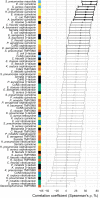The distribution of antibiotic use and its association with antibiotic resistance
- PMID: 30560781
- PMCID: PMC6307856
- DOI: 10.7554/eLife.39435
The distribution of antibiotic use and its association with antibiotic resistance
Abstract
Antibiotic use is a primary driver of antibiotic resistance. However, antibiotic use can be distributed in different ways in a population, and the association between the distribution of use and antibiotic resistance has not been explored. Here, we tested the hypothesis that repeated use of antibiotics has a stronger association with population-wide antibiotic resistance than broadly-distributed, low-intensity use. First, we characterized the distribution of outpatient antibiotic use across US states, finding that antibiotic use is uneven and that repeated use of antibiotics makes up a minority of antibiotic use. Second, we compared antibiotic use with resistance for 72 pathogen-antibiotic combinations across states. Finally, having partitioned total use into extensive and intensive margins, we found that intense use had a weaker association with resistance than extensive use. If the use-resistance relationship is causal, these results suggest that reducing total use and selection intensity will require reducing broadly distributed, low-intensity use.
Keywords: E. coli; S. pyogenes; antibiotic resistance; antimicrobial; epidemiology; global health; infectious disease; microbiology; public health.
© 2018, Olesen et al.
Conflict of interest statement
SO, MB, DM, JB, SH, YG No competing interests declared, ML Reviewing editor, eLife
Figures










Comment in
-
Response to comment on 'The distribution of antibiotic use and its association with antibiotic resistance'.Elife. 2019 May 3;8:e47124. doi: 10.7554/eLife.47124. Elife. 2019. PMID: 31050649 Free PMC article.
-
Comment on 'The distribution of antibiotic use and its association with antibiotic resistance'.Elife. 2019 May 3;8:e46561. doi: 10.7554/eLife.46561. Elife. 2019. PMID: 31050650 Free PMC article.
References
-
- Benjamini Y, Hochberg Y. Controlling the False Discovery Rate: A Practical and Powerful Approach to Multiple Testing. Journal of the Royal Statistical Society. 1995;57:289–300. doi: 10.1111/j.2517-6161.1995.tb02031.x. - DOI
Publication types
MeSH terms
Substances
Grants and funding
LinkOut - more resources
Full Text Sources
Medical

